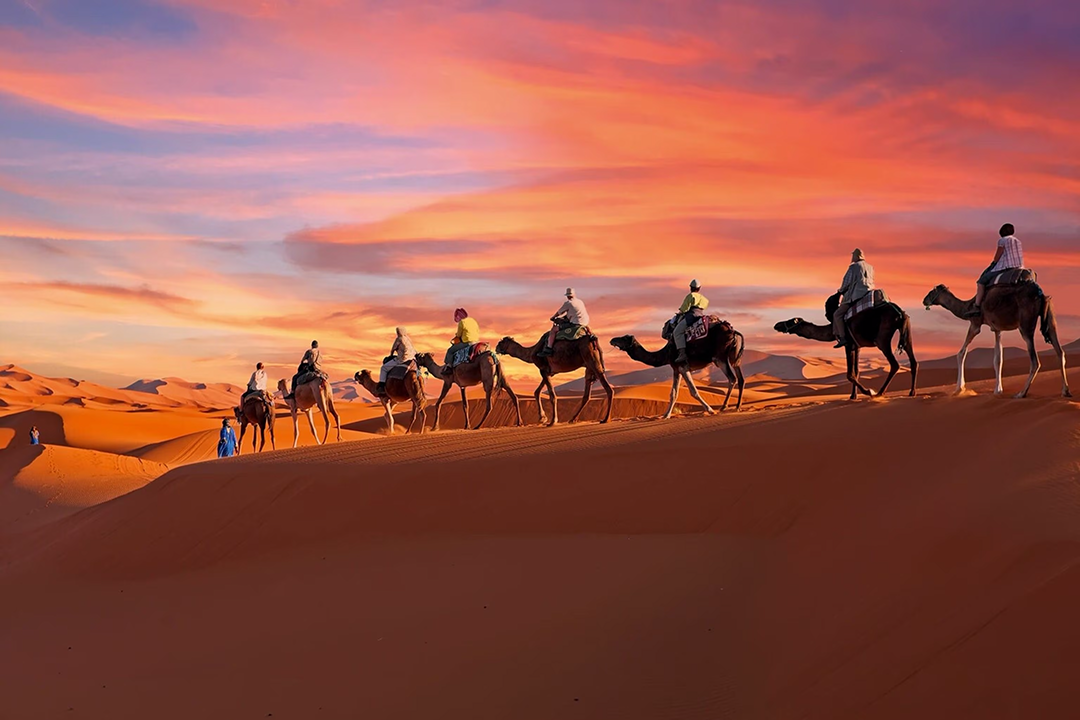
Ancient Trade Routes of Morocco: How They Shaped the Country
Unveiling the Paths of Prosperity: The Impact of Old Caravans on Modern Morocco.

The Legacy of Morocco’s Ancient Trade Routes
Long before the advent of modern transportation, Morocco was a crossroads of civilizations, connected to the world through a network of ancient trade routes. These routes, traversed by caravans of camels and merchants, brought goods, ideas, and cultures from across Africa, Europe, and the Middle East. They not only fueled Morocco’s economy but also shaped its identity, leaving a lasting impact on its architecture, culture, and traditions. Let’s journey through the paths of prosperity that defined Morocco’s past and continue to influence its present.
1. The Trans-Saharan Trade Routes
The Trans-Saharan trade routes were the lifeblood of Morocco’s economy for centuries. These routes connected sub-Saharan Africa with North Africa and the Mediterranean, facilitating the exchange of gold, salt, ivory, and slaves. Cities like Sijilmasa and Marrakech flourished as key trading hubs.
- Sijilmasa: Once a thriving oasis city, it was the starting point for caravans heading south to Timbuktu.
- Marrakech: Known as the “Red City,” it became a major center for trade and culture under the Almoravid dynasty.
- Goods traded: Gold from West Africa, salt from the Sahara, and luxury items like spices and textiles.
2. The Salt Caravans of the Sahara
Salt was one of the most valuable commodities traded along the ancient routes. Caravans transported salt from mines in the Sahara to markets in Morocco and beyond. The Salt Road was a perilous journey, but its rewards were immense.
- Taghaza: A remote salt-mining town in the Sahara, known as the “City of Salt.”
- Caravan routes: These paths often passed through oases, providing water and rest for travelers.
- Cultural impact: The salt trade influenced Moroccan cuisine, with preserved foods becoming a staple.
3. The Role of Berber Merchants
The Berbers, Morocco’s indigenous people, played a crucial role in the success of the trade routes. As skilled navigators and traders, they facilitated the movement of goods and ideas across vast distances.
- Berber caravans: These groups were known for their expertise in crossing the desert.
- Cultural exchange: Berber merchants introduced Moroccan goods to sub-Saharan Africa and brought African influences back to Morocco.
- Legacy: Berber traditions, language, and craftsmanship remain integral to Moroccan culture.
4. The Influence of Islamic Trade Networks
With the spread of Islam, Morocco became part of a vast network of trade that extended from Spain to India. Islamic principles of commerce, such as fair trade and trust, helped establish Morocco as a reliable trading partner.
- Fes: This city became a center of learning and commerce, attracting scholars and merchants from across the Islamic world.
- Trade goods: Moroccan leather, ceramics, and textiles were highly sought after.
- Architectural influence: Islamic design elements, like geometric patterns and calligraphy, became prominent in Moroccan architecture.
5. The Mediterranean Connection
Morocco’s strategic location on the Mediterranean coast made it a gateway between Europe and Africa. Port cities like Tangier and Essaouira thrived as centers of maritime trade.
- Tangier: Known as the “Door of Africa,” it connected Morocco to Europe and the Middle East.
- Essaouira: A fortified port city that traded goods like argan oil and thuya wood.
- Cultural fusion: The Mediterranean trade brought European influences to Moroccan art, cuisine, and architecture.
6. The Impact on Moroccan Cities
The wealth generated by trade transformed Morocco’s cities into vibrant centers of culture and commerce. Palaces, mosques, and markets were built, showcasing the country’s prosperity.
- Marrakech: The Koutoubia Mosque and Jemaa el-Fnaa square are testaments to its trading legacy.
- Fes: The medina of Fes, a UNESCO World Heritage Site, is home to ancient tanneries and madrasas.
- Chefchaouen: This blue-painted city was a resting point for traders and remains a cultural gem.
7. The Decline and Legacy of the Trade Routes
With the advent of European sea routes and colonialism, the ancient trade routes gradually declined. However, their legacy lives on in Morocco’s culture, architecture, and traditions.
- Cultural heritage: Moroccan music, art, and cuisine reflect the influences of its trading partners.
- Historic sites: Many caravanserais (inns for travelers) and kasbahs have been preserved as cultural landmarks.
- Modern trade: Morocco continues to be a hub for trade, with modern ports and highways replacing ancient routes.
Exploring Morocco’s Trade Route Heritage
To experience the legacy of Morocco’s ancient trade routes, consider these activities:
- Visit the Ait Benhaddou kasbah, a UNESCO site that once served as a trading post.
- Explore the Fes medina, where ancient tanneries and markets still operate.
- Take a camel trek in the Sahara to follow in the footsteps of the caravans.
- Shop for traditional goods like Moroccan rugs, pottery, and spices in local souks.
Final Thoughts
Morocco’s ancient trade routes were more than just pathways for goods—they were conduits of culture, knowledge, and connection. They shaped the country’s identity and laid the foundation for its vibrant, diverse society. Today, as you wander through Morocco’s bustling markets, admire its architectural wonders, or savor its rich cuisine, you’re experiencing the enduring legacy of these historic routes. So, take a moment to appreciate the paths of prosperity that have made Morocco the captivating destination it is today.
